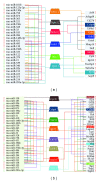MicroRNAs in the Neural Retina
- PMID: 24745005
- PMCID: PMC3972879
- DOI: 10.1155/2014/165897
MicroRNAs in the Neural Retina
Abstract
The health and function of the visual system rely on a collaborative interaction between diverse classes of molecular regulators. One of these classes consists of transcription factors, which are known to bind to DNA and control the transcription activities of their target genes. For a long time, it was thought that the transcription factors were the only regulators of gene expression. More recently, however, a novel class of regulators emerged. This class consists of a large number of small noncoding endogenous RNAs, namely, miRNAs. The miRNAs compose an essential component of posttranscriptional gene regulation, since they ultimately control the fate of gene transcripts. The retina, as a part of the central nervous system, is a well-established model for unraveling the molecular mechanisms underlying neuronal and glial functions. Numerous recent efforts have been made towards identification of miRNAs and their inferred roles in the visual pathway. In this review, we summarize the current state of our knowledge regarding the expression and function of miRNA in the neural retina and we discuss their potential uses as biomarkers for some retinal disorders.
Figures



References
-
- Tarver JE, Donoghue PC, Peterson KJ. Do miRNAs have a deep evolutionary history? Bioessays. 2012;34(10):857–866. - PubMed
-
- Lim LP, Glasner ME, Yekta S, Burge CB, Bartel DP. Vertebrate microRNA genes. Science. 2003;299(5612):p. 1540. - PubMed
-
- Huntzinger E, Izaurralde E. Gene silencing by microRNAs: contributions of translational repression and mRNA decay. Nature Reviews Genetics. 2011;12(2):99–110. - PubMed
Publication types
Grants and funding
LinkOut - more resources
Full Text Sources
Other Literature Sources

